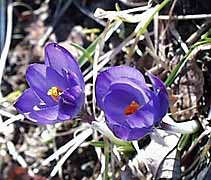Sagadahoc Stories #86:
Coyote Moon

Hunched
(after Barlach)
|
The seasons have been playing prank again. Teasing us with mildness,
then slapping us upside with a chill. Reggie, Peggy's magic masseuse,
says there's so much neck and back pain this time of year because
we're all hunched up against the winter. It feels like a load
lifting when the frost goes out, but a raw day in April can make
you cringe and hunker. Just let it be over. Come Spring. |
| The frost is going out with a rush, and robins are hopping after
worms. The gription let go of my winter ravens, and I yanked them
from the front lawn. Enough with the darkness. But the back quarter
acre is deep sog, too mushy for planting ornaments or tap dancing.
I've had to jack the Eagles every morning to close the door, and
my raised walkway needs shimming by sunset. Living on outwash
clay makes Spring a sinking time. |
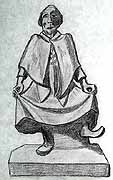
Spring Dance
(after Barlach)
|
I've been reading a pop geology of Maine, and the earthy history
of these parts sounds much like recent times. Waves of invaders
slamming up against the old rocks, bending the settled shape of
things, and retreating. In this case plates of proto-Europe and
proto-Africa crunching us. Submerging remnants of the alien assault
roil beneath the surface, send up hot plutons which turn to stubborn
granite in the Maine air. The succession of events runs roughly
parallel to the coast, so the farther upcountry you go, the earlier
the tortured features and more stubborn the record. Just like
natives retreating before coastal in-migrants.
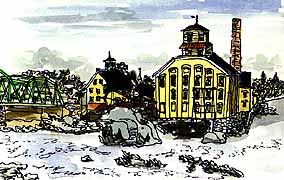
Bowdoin Mill
|
The text explains why the Androscoggin makes its sharp turn at
the Topsham and heads back upcountry into Merrymeeting Bay. The
Norumbega Fault runs under the watercourses from the Bowdoin Mill,
down the Androscoggin, along the length of the Bay, and up the
Kennebec. It marks the impact zone of crustal collision, along
a line that runs from New Brunswick to Connecticut, where the
Avalon terrane thrust up the Acadian mountains during early Devonian
time. This was when proto-Europe was colliding with Maine. |
Later proto-Africa slammed into us, shifting the plates along
the fault as it thrust up mountains in the Alleghanian orogeny.
The movement of the Avalonian remnants along the fault has brought
in highly metamorphosed rocks from farther west. These coastal
migrants were created by the injection of hot magma in the Sebago
pluton, and the incursion of these less easily eroded rocks alongside
the softer rock (Cushing formation) on the west side of the fault
turned the path of later river building onto the fault line. At
least I think that's what it said.
As hot magma intrudes, it metamorphoses old bedrock and congeals
into different geologic species. In places where the cooling goes
very slowly, rare elements which don't easily combine into smaller
crystals tend to concentrate. When this odd soup does chill out
there may be dikes and sills of pegmatite, a coarse-grained granite
containing large crystals of mica, feldspar, and gem stones like
tourmaline. Just such intrusions outcrop down in Topsham where
the Cathance rises.
In the 19th century pegmatite mining in the Topsham quarries was
a going business. Feldspar was crushed and barged down the Cathance
from the headwater mill, and shipped to ceramic factories in such
exotic places as Trenton, New Jersey, where it's used as an ingredient
in porcelain. Later feldspar was crushed at a mill where the railroad
crossed Route 24, and shipped out by rail. Local feldspar mining
is now as defunct as the Alleghanian orogeny.
|
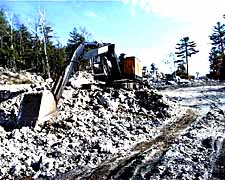
|
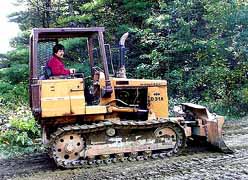
|
In latter days, geologically, ice ages buried the landscape, like
economic depressions, scouring the surface and sinking the bedrock,
only to melt away leaving a rawboned environment. The ice retreats,
dumping its scrapings into gravel pits and clay deltas. The land
recoils, then subsides as the seas rise, leaving a drowned coast
and a town full of outwash clay. You can see the clear demarcation
between the alluvial landscape and the bold granites as you sail
from Bowdoinham across to chops. Small wonder the early settlers,
coming upriver from that hard coast, rushed to plant farms along
the Abby shores, in the fat soil. |
Peggy has spinach, lettuce, beets and chard planted in our clay
already, dreaming about salads. The sheltered beds facing South
are apoke with sproutings and buds. We've been cleaning the gardens
and raking away dog winter. CC has found the deck by the Eagles
a great place to loll in the sun, and snoozed away while a hen
pheasant came striding past one afternoon. Woodcocks are peeenting
in the woods, and woodpeckers rattling. One pair was alternately
drumming on a hollow willow by the river and a telephone pole.
It sounded more like a ritual conversation than a bug hunt. When
I echoed the beat they both stopped and looked at me. The worms
are rising into thawed ground, and mixed flocks of blackbirds,
robins, and grackles are sucking up the annelids
Monday morning Eric the sawyer jingled me, asking if I wanted
that pine planking. He had another customer interested, but wanted
me to have first dibs. Ebba is still napping, so I jumped on the
bike to pedal over to Bowdoin. Seemed like a good idea, but I
hadn't counted on the wind. A dead muzzler and starting to puff
up. Half way out the Millay Road I was in low-low gear and pumping
hard to make headway. By the time I got to 201 I was a panting
puppy. Eric actually set out looking for the dead body, but had
gone round the other way, and we arrived at his drive together.
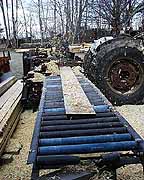
|
We flipped rough-sawn five-quarter, as I picked out the best wide
boards. I'd calculated that 450 square feet would give me enough
and to spare for this frigate, but it took us three tries to get
the numbers right, passing stock back and forth into his building.
I warned him that doing the arith with me would fog anyone's brain.
|
| Then he took the side cutters off his antique Wood's Mfg. Inc.
planer, set the blades for one and an eighth, connected the tractor
PTO, and fired the beast up. The wind plumed wood chips over the
yard while the planer sang. We had to make two passes to plane
both sides down to one inch, and I tailed on and loaded Eric's
truck with the finished stock. We pitched the bike on top and
took it all home. I racked it up on top of Sharpie. Now I'm committed
to new boat. Mmm. The smell of fresh milled pine rising in the
sunshine. |
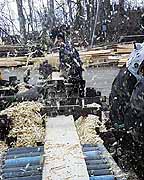
Planing
|
It was full moon on the first, and I wondered what kind of mayhem
would confuse me on my favorite holiday. It didn't take long to
find out. Morse's lumber truck back-beeped up the drive with my
oak around 8 AM. Lovely long chine pieces and sheer clamps, keelson
stock, thwarts, framing materials. Then there was the piece I'd
ordered for the skeg. What on earth had I been thinking? Here's
this massive baulk of white oak, nine inches by four inches by
eighteen feet long!
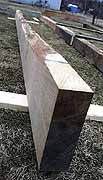
|
The driver gives me a quizzical look as he asks,"What are you
building?" Good question. With that thing I could be constructing
Noah's arc. I hadn't really focused on hefting it onto a saw,
let alone cutting it. We rolled it off the truck using a short
section of well-casing, grunted it onto some sleepers, and I paid
the bill. The driver was still shaking his head when he drove
off. I can barely hump this monster around the yard, and haven't
a clue how I'm going to deal with it. The joke's on me.
|
| But I'm seriously started. Took me all one day to set up my strongback.
Parallel six-by-sixes leveled and squared and cross tied. Six
feet apart and 24 feet long. Stations marked off and a baseline
strung from centers. Most of the futzing was with figures. It
should be simple enough to convert measurements from a 42 footer
to 24. Just multiply everything by 24 and divide by 42. Which
leaves you with decimal fractions, however, and by the time you're
down to inches and 8ths, you don't know which digit is up. Then
I'm using at least three bulkheads (or partial ones) in lieu of
molds, and figuring their placement, where the remaining molds
should be stationed, and allowing for the supporting lumber had
me tearing hair by mid-afternoon. It wasn't until the sun was
setting that I got the last index marks on the strongback. Geez
it looks like a big boat. |
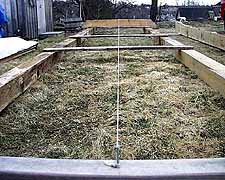
|
Between playful weather and the wood jokes you'd think Coyote
had had enough fun for Fool's Day. But he had me playing foot-in-mouth
on the web, too. Turns out my idle clucking about town affairs
has reached more local ears than I suspected, and the chickens
are coming home. Some of my dispatches have been run off and circulated
in Samizdat to various town officials, who, in turn have approached
people I've mentioned over the months, asking pointed questions.

OOOPS
|
"Did you know Bryce talked about blowing up your duck's ass?"
Jimmy was queried. And so forth. Word came back that not everyone
was amused. The issue of personal web publication and violations
of privacy rose their uglies again. Where does an artist's journal
leave off and local politics begin? Where's the thin line between
public utterance and private discourse? It doesn't help that I
tend to colored adjectives and irony. What you might call a smart
mouth. Some ears are tingling, including mine.
|
All of which may be a cyclone in a coffee clatch, but it reveals
how new this medium is, and how unknown its effects. Peggy sees
this episode as part of the dynamic of local gossip as analyzed
by anthropologists. Talking trash as moral recycling, and politics
of place.
| Gossip is generally considered to be titillating innuendo and
negative raps circulated behind the subject's back, to denigrate.
Pissin and dissin. The anthros see it rather as the way bad behavior
is sanctioned without direct confrontation, and how informal politics
works in small communities. Gossip is a value-laden information
exchange, which results in normative messages getting conveyed
to those who misbehave, or disagree with you. I cluck to sis about
what you said or did, she tells Susy, whose brother tells you.
Everyone in the loop puts a twist on the telling, which informs
the message with individual bias, and also begins to establish
consensus points of view. |
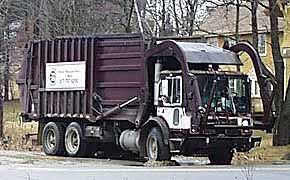
|
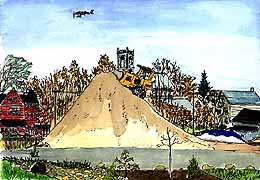
Sand Pile
|
Someone down at the sand pile tells me it's a damned foolishness
to create a $25 local license fee for smelt camps, just because
a few out-of-towners leave trash on the ice, and the wardens are
too busy to enforce the state regs. This gets chatted around the
camp owners and other ice-clowns, and we discover there's a consensus
against the new regs. It's all gossip. Negative remarks directed
at "whoever" came up with this bright idea. But, if the dynamic
works, either the originators of the proposal get the message
and ditch the idea, or those opposed get together and vote it
down at meeting. Or try to.
|
| Political gossip is one thing. If you get involved in town government
you have to expect your ears to burn. When gossip is about personal
behavior, however, it can be less useful, and more harmful. It
may keep those who care about their local image in line, but gossip
can also reinforce all kinds of nasty prejudice, and the clucking
turn to pecking. Most Mainers tend to accept a wide variety of
deviance, fortunately, or a lot of us would have to keep moving.
I've acquired a taste for gossip over the years, because I see
its utility, and want to keep my ear to the ground. I'm also a
natural tattle. |
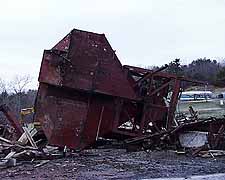
|
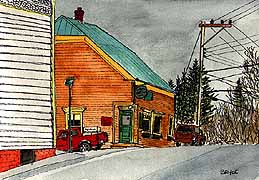
Lodge & Landing
|
The old structures of local politics are getting torn down, however.
In the days when everyone worked in town at similar jobs, political
issues got thoroughly hashed out at the watering holes long before
they went to a vote. Everyone knew where the gossip was on tap,
passed it around, and came to a position before town meeting.
Meeting was a ritual event where a familiar cast of characters
acted out for all of us. It was a chance to bare grievances, blow
hard, vote the predetermined, and enjoy the show. The store, the
restaurant, the gas station, the dump, the post office, the landing,
the sand pile, the lodges, the grange, the churches, the socials,
were all places to gossip and do ad hoc politics. We're rapidly
losing those venues, and few newcomers know how important they've
been. Or still are. |
| An in-migrant to a small town may think that nobody's taking any
political responsibility, because traditional politics is invisible.
Just a bunch of guys jawing at the dock, or ladies having a gab.
The newcomer wants to get involved in town affairs, so he joins
a committee. A well-intentioned civic act. The problem is that
decision-making by committee (and hired officials) is a white-collar
corporate model of management, which grates against the old ad
hoc consensus. Committee governance, when it's alienated from
an egalitarian consensus, feels like disenfranchisement by an
elite. Self-selected "leaders" getting big headed and pushing
the rest of us around. Committee members assume they are representing
town opinions, when they often can't see past their class prejudices,
or committee group-think. Why should they? They don't go out and
hear the critical gossip which might bring them up short. And
if they hear the gossip, that sort of sarcastic bombast is obviously
just a bad actor mouthing off. |
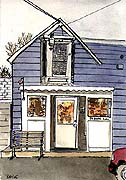
Store Entrance
|

|
Enter a web site. I've been gossiping in this venue. Expressing
my jaundiced views to my friends, and telling tales. I've tried
to be kind, and not to speak for anyone but myself, but some folks
have been tarred with my brush, apparently. Maybe it's because
this gab is in print that it gets treated as formal journalism
instead of what it is: a personal hobby-horse. An attempt at an
artform. Because I said he said in text it becomes news, instead
of gossip, or caricature? Maybe because some statements have been
excerpted in Samizdat they've taken on the flavor of a tabloid.
Still: should I be surprised that e-gossip sets tongues clacking?
I'm amused that nobody who disagrees with my positions, or feels
personally attacked, has addressed me directly. They've said he
said to those who've told me. Web site as gossip. Coyote having
us on again. |
(CLICK HERE TO HOWL BACK)







